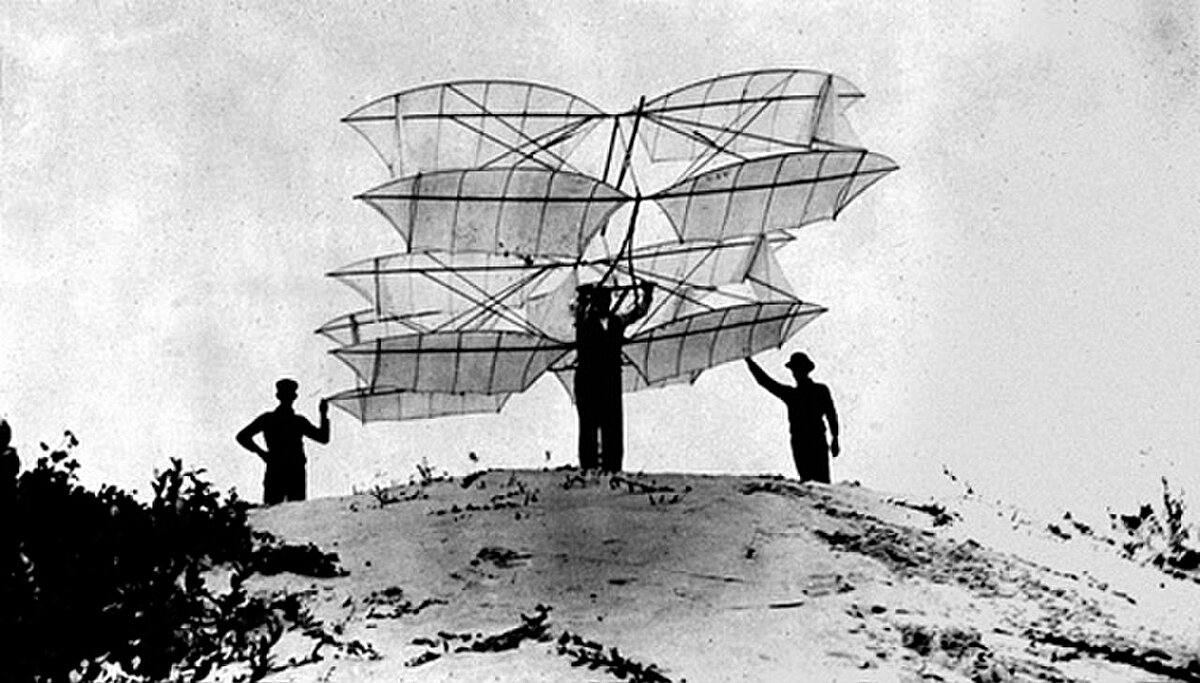Octave Chanute’s Glider Designs
One of Octave Chanute’s glider designs, called the Katydid and designed in 1896. It featured 12 wings and was tested out on Miller Beach, Indiana.
Pictured above is a twelve-winged glider designed by Octave Chanute from 1896. It’s one of many flying machines Chanute experimented with, and like the others, it directly influenced other pioneers of aviation. Chanute began his career as a civil engineer, and he made a name for himself building railroads and bridges. After retiring in 1883, he turned his attention to aviation, which was a subject he’d been interested in for decades prior.
From 1891 to 1893, Chanute published a series of articles in The Railroad and Engineering Journal, which would later be republished in the book Progress in Flying Machines in 1894. It was an influential survey of heavier-than-air aviation, and it was the most comprehensive study of it’s kind at the time. Following this, Chanute began work on his own glider designs and tested them at Miller Beach, Indiana. His first major experiments were based on the belief that adding more wings to a design would lead to greater lift. The twelve-winged glider pictured above was the first application of the idea. Subsequent versions had fewer wings but were still based on the same concept.
A bi-winged glider design by Octave Chanute from 1896. This design introduced a strut system meant to strengthen the wings, and it would serve as inspiration for the Wright Brothers.
After the many-winged glider experiments, Chanute turned his attention to a bi-winged glider design. Pictured above is one version. He introduced a refined strut system to the wings to give them added rigidity, and he had success getting the craft to glide from the top of a hill. These designs bring to mind Otto Lilienthal, who was a collaborator of Chanute with very similar glider designs. The patent below looks quite similar to a patent from two years earlier, obtained by Lilienthal. This wasn’t a problem, however, because Chanute believed knowledge and designs should be shared among aviation pioneers, and he frequently collaborated with others who were attempting to fly.
Patent drawing from Octave Chanute’s 1897 design for a glider. Called Soaring Machine, the design is siilar to Otto Lilienthal’s glider designs.
Two such collaborators were the Wright Brothers. After reading Chanute’s Progress in Flying Machines, Wilbur Wright contacted Chanute, and the two subsequently corresponded from 1900 to 1910. When the Wright Brothers achieved the first controlled flight of a heavier-than-air aircraft in 1903, their design was based on Octave Chanute’s bi-winged glider, pictured above. They would continue collaborating for seven more years after that, but disagreements over sharing knowledge caused them to cease correspondence. Chanute believed in a free exchange of ideas, while the Wright Brothers wanted to sue other inventors who they believed had stolen their ideas.
Octave Chanute is a key figure in the history of human flight, and he acts as the glue for the profession during the years he was active. He believed in collaboration and the free exchange of knowledge and ideas, and this spirit inspired many others to pursue flight. In the end, it led to the world’s first controlled flight of a heavier-than-air craft.
Read more about other ideas for flying machines here.



